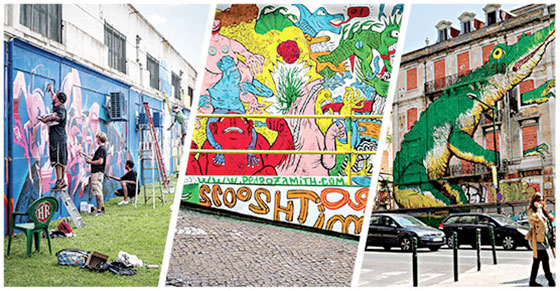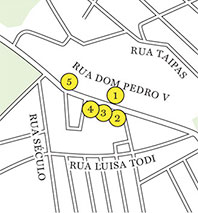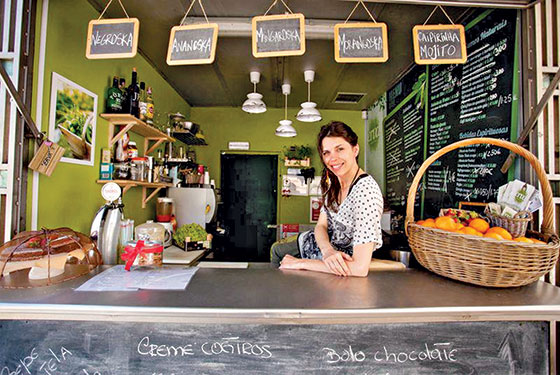
Art in the Avenidas
While street art first appeared in Lisbon following the 1974 revolution, it didn’t ramp up until the mid-nineties, when artists began aggressively tagging, scribbling, and stenciling the city. Crackdowns and cleanups followed, but have relaxed in recent years; the City Council even extended a conciliatory hand by designating legal canvassing zones. Here, local graffiti king Alexandre Farto, a.k.a. Vhils, on where to catch the circuit’s most storied street art.
The Hall of Fame
Avenida Conselheiro Fernando de Sousa
“In the district of Amoreiras, located on several blocks around the main Avenida, there’s a legal—or near-legal—wall where the city’s most skilled graffiti writers paint without hassle.”
Fábrica do Braço de Prata
Rua da Fábrica de Material de Guerra 1
“This former ammunition factory in eastern Lisbon has pieces by Mar, a painting by Dirty Cop, and a carving by me.”
Avenida Fontes Pereira de Melo
Between Praça Marquês de Pombal and Praça Duque de Saldanha
“Here you can see pieces by Brazil’s Os Gêmeos and Italian artist Blu on the façades of two boarded-up buildings.”
LxFactory
Rua Rodrigues de Faria 103; lxfactory.com
“Check out this old factory turned cultural and business hub in Alcântara: Recent works here include a large mural by Mar and another by Diogo Machado, who does work based on azulejos, or Portuguese tiles.”
Montana Shop & Gallery
Rua da Rosa 14G; 912-993-675
“Every two months, this Bairro Alto gallery showcases great exhibitions by local and international street artists such as Aryz and Pedro Matos.”
Galeria de Arte Urbana
Galeriaurbana.com.pt
“Worth a peek are the legal walls recently created in Calçada da Glória, a pedestrian street along which the funicular runs up to Bairro Alto. GAU is an urban-art initiative that promotes Lisbon street art.”

Boutique Row
Rua Dom Pedro is to Príncipe Real what West Broadway is to Soho: a shopper’s nirvana. Here, Lisbon fashion designer Alexandra Moura plots five noteworthy stops along the route.
1. Fabrico Infinito
Rua Dom Pedro V 74 213-801-141
“Visit Fabrico for its vintage lamps from the seventies and eighties, a wonderful selection of new and used art books, and a backyard overseen by NATA, a bakery that makes amazing pastel de nata tarts. Have one in the garden while taking in the perfect view of the Lisbon hills.”
2. Óptica Príncipe Real
Rua Dom Pedro V 75 213-460-711
“This beautiful new eyewear boutique carries brands like Miu Miu, Versace, and Prada and has an art-filled area where you can sip tea or coffee while waiting for the optician.”
3. Kolovrat79
Rua Dom Pedro V 79 213-874-536
“Bosnian-born, Lisbon-based womenswear designer Lidija Kolovrat showcases her avant-garde line here. There’s also a huge studio loft on the second floor she uses for parties and concerts.”
4. Em Nome da Rosa
Rua Dom Pedro V 97-99 919-755-122
“This florist carries rare flowers like Peruvian lilies, birds of paradise, wild leek, and coral-bead plants; owner Maurício Fernandes creates uniquely beautiful bouquets.”
5. Espaço B
Rua Dom Pedro V 120 213-461-210
“This minimalist store sells international and local brands, like Dino Alves. Browse Fred Perry slim-fit shirts, Muuñ Paris bags, Sofie D’Hoore dresses, Deux Souliers wedges, Nixon watches, and Comme des Garçons perfumes.”

Reverse Colonization
For better or for worse, Lisbon wouldn’t be the worldly city it is today without Portugal’s colonial muddling in Angola, Cape Verde, Mozambique, Goa, and beyond. Evidence of that reach can be seen everywhere from its Capeverdian bean stews to its Luso-African dance clubs. Kalaf Angelo, the Angolan emcee of the kuduro musical collective Buraka Som Sistema, highlights the best spots for taking in the city’s global offerings.
Mercado Fusão
Praça Martim Moniz “Last year, entrepreneur José Filipe Rebelo Pinto founded a market that filled Martim Moniz Square with restaurants, shops, art, and music from South America, Africa, and Asia. It’s like he re-created the different worlds that Portuguese sailors encountered and brought back home during the fifteenth century.”
Escola 1001 Danças
Rua Portas de Santo Antão 110; 964-781-886
Dock’s
Rua da Cintura do Porto de Lisboa; 226 961-147-456
“Kizomba is the most popular music-and-dance genre in Portuguese-speaking Africa. Created in Angola, it’s a mix of traditional rhythms like semba and zouk, and the dance is done in pairs. Take a lesson at Escola 1001 Danças, and then practice your steps at Dock’s, a club where you can also hear kuduro and Afrohouse.”
Associação Caboverdeana
Rua Duque de Palmela 2, eighth fl.; 213-593-367
“Cachupa, a slowly cooked corn-and-bean stew, is served here at lunchtime every Tuesday and Thursday. Mingle with a Capeverdian crowd, as well as execs from the nearby banks and insurance companies, as you listen to mornas and coladeiras.”
Fado Finder
The Portuguese take their fado—folk music marked by soulful vocals and guitar—seriously. Fado singer Cuca Roseta offers a musical tour through Alfama, a maze of narrow alleys and hidden concert halls.

“Go to the Museu do Fado (Largo do Chafariz de Dentro 1; 218-823-470) to learn about its history. Come on weekends around 6:30 p.m. for a visita cantada, a guided tour that culminates with a live concert.”
“Pay respects to fado icon Amália Rodrigues at Panteão Nacional (Campo de Santa Clara), the church where her body rests. Look for it in Sala Tumular, located to the right of the church.”
“Set out for a night crawl around 7:30 p.m. with the fado hobbyists at A Baiuca (Rua de São Miguel 20; 218-867-284), a minuscule spot where you can start the evening off with a glass of wine.”
“Next up is Clube de Fado (Rua São João da Praça 86-94; 218-852-704; reservations suggested), five minutes away. This is where the pros perform. I sing there, too; it’s like my other home.”
“Ten minutes from Clube de Fado is the intimate Mesa de Frades (Rua dos Remédios 139A; 917-029-436). This is where all the fado singers go after work—around 1 a.m.—to have a nightcap.”